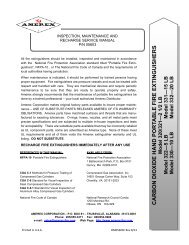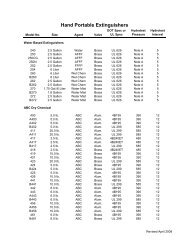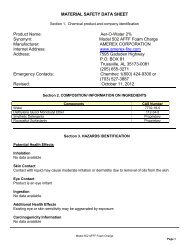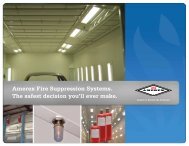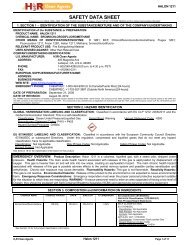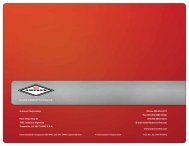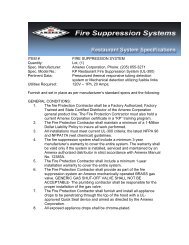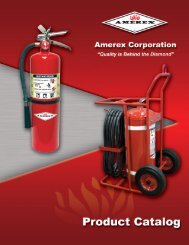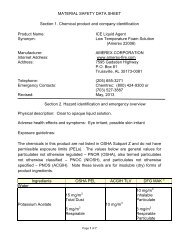Manual for Class D wheeled extinguishers.pdf - Amerex Corporation
Manual for Class D wheeled extinguishers.pdf - Amerex Corporation
Manual for Class D wheeled extinguishers.pdf - Amerex Corporation
Create successful ePaper yourself
Turn your PDF publications into a flip-book with our unique Google optimized e-Paper software.
7. Disconnect the regulator from the agent cylinder. Visually examine the regulator and high pressure hose <strong>for</strong> signs<br />
of damage, corrosion or deterioration. To per<strong>for</strong>m the regulator static pressure, dead set and minimum pressure<br />
flow rate checks:<br />
a) Connect the proper service kit ADAPTER (P/N: 01740) to the low pressure outlet port of the regulator.<br />
b) Connect the service kit HOSE ASSEMBLY (P/N: 01410) and FLOW CHAMBER (P/N: 01250) to the<br />
regulator low pressure port adapter.<br />
8. Make sure all service kit connections are secure and that the kit flow chamber is CLOSED. Check the ARGON<br />
cylinder pressure to ensure that it is within the acceptable operating range. Hold the kit flow chamber in one<br />
hand and slowly open the Argon cylinder (with either “T” handle operating lever or by turning the handwheel if so<br />
equipped). Observe flow chamber pressure reading to see if it is within the recommended static dead set<br />
pressure parameters <strong>for</strong> the Models 680 & 681 regulator listed below.<br />
Regulator Type Static Dead Set Pressure Minimum Flow Pressure<br />
Victor 120 ± 10 PSI 110 PSI minimum<br />
WARNING: IF THE PRESSURE READING EXCEEDS THE GIVEN PARAMETERS, QUICKLY CLOSE THE ARGON<br />
CYLINDER “T” HANDLE OR HANDWHEEL VALVE AND VENT THE PRESSURE BY OPENING THE FLOW<br />
CHAMBER BALL VALVE.<br />
REGULATORS CANNOT BE FIELD ADJUSTED. THEY MUST BE REPLACED IF FOUND TO BE OUT OF TOLERANCE.<br />
9. Observe the proper regulator static dead set pressure <strong>for</strong> a minimum of one minute, then fully open the flow<br />
chamber valve <strong>for</strong> 1 - 2 seconds. Observe the pressure reading to ensure that the flow pressure does not drop<br />
below the minimum specified. Close the Argon cylinder valve after the test and vent the flow chamber pressure<br />
by opening the flow chamber valve.<br />
Note: Prior to per<strong>for</strong>ming the minimum flow check, make sure that the nitrogen cylinder valve (“T” handle or<br />
handwheel) is FULLY OPEN so that it does not restrict or alter the flow readings.<br />
WARNING: ALWAYS OPEN THE SHUTOFF NOZZLE HANDLE SLOWLY. ANY PRESSURE IN THE AGENT CYLINDER<br />
WILL CAUSE THE EXTINGUISHER TO DISCHARGE. BE PREPARED FOR A POSSIBLE DISCHARGE AND<br />
NOZZLE RECOIL. ANY EVIDENCE OF AGENT IN THE NOZZLE INDICATES THAT THE UNIT MAY HAVE<br />
BEEN USED AND THE USE NOT REPORTED.<br />
10. Disconnect the discharge hose from the agent cylinder. Check the couplings, hose and hose gaskets <strong>for</strong> damage<br />
or deterioration – replace as necessary.<br />
11. To per<strong>for</strong>m an operational integrity check on the discharge hose and nozzle combination:<br />
a) Connect the test kit hose adapter to the female end of the discharge hose.<br />
b) Close the discharge nozzle shut-off lever and properly secure it.<br />
c) Connect a properly regulated and verified nitrogen pressure source (set to the extinguisher operating<br />
pressure [110 - 130 psi] to the test kit hose adapter.<br />
d) Slowly pressurize the discharge hose/nozzle assembly to the extinguisher operating pressure and check<br />
<strong>for</strong> leaks or distortion.<br />
e) Operate the nozzle lever to ensure proper operation and to clear the hose of any obstructions (if hose is<br />
obstructed - refer to the TROUBLE SHOOTING section of this manual.<br />
f) Close the nitrogen pressure source and relieve remaining pressure by slowly and fully opening the nozzle lever.<br />
12. Remove the agent cylinder cap and examine it closely <strong>for</strong> signs of damage, cracks or thread wear. Clean the<br />
agent cylinder fill cap threads and thread vent port on the cap with a stiff bristle nylon brush. Remove the fill cap<br />
gasket and check <strong>for</strong> wear, cracks or tears - replace if necessary. Lightly lubricate the gasket with Visilox 711<br />
and reinstall.<br />
13. Examine the condition of the chemical agent <strong>for</strong> proper type and condition. Replace chemical that is contaminated,<br />
caked or different than the type indicated on the nameplate (label). Do not trust to the “height” of the<br />
chemical when determining agent fill. Dry powder will settle and the only true indication of agent fill is to weigh<br />
the extinguisher and compare with the weight indicated on the nameplate (label).<br />
14. Place the service kit VENT SPACER (P/N: 01530) on top of the agent cylinder fill opening collar. Check again to<br />
see that the fill cap thread vent is clean and that the agent ill cap gasket is in place. Install the agent fill cap<br />
securely over the vent spacer.



